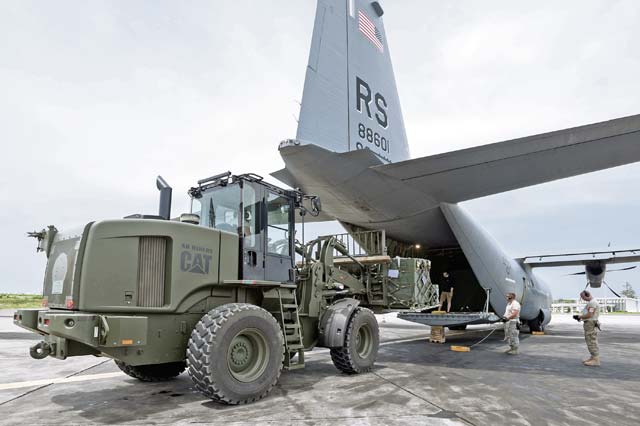
Aerial porters from the Kentucky Air National Guard’s 123rd Contingency Response Group load a pallet of red blood cells and frozen plasma onto a C-130J Super Hercules from Ramstein Oct. 10, 2014, at Leopold Sedar Senghor International Airport in Dakar, Senegal. The aerial porters are part of Joint Task Force-Port Opening Sengal, an air cargo hub that’s funneling humanitarian supplies and equipment into West Africa in support of Operation United Assistance, the U.S. Agency for International Development-led, whole-of-government effort to respond to the Ebola outbreak there.
After more than four months of continuous airlift support to Operation United Assistance, the U.S. Air Force is winding down efforts in Senegal, Monrovia and Liberia.
To help counter the deadly Ebola virus, Airmen from U.S. Air Forces in Europe and Air Forces Africa, as well as Air Mobility Command and Total Force partners, provided a vital air bridge into Liberia.
“No military in the world can do what we did in Africa,” said Gen. Frank Gorenc, USAFE-AFAFRICA commander.
Aircraft from the 37th Airlift Squadron on Ramstein and Total Force C-130s assigned to the 787th Air Expeditionary Squadron in Dakar, Senegal, flew 114 missions, transporting more than 1,000 passengers and nearly 1,750 tons of cargo, including food, water and medical
supplies.
Additionally, a total of 14 Air Mobility Command units from across the U.S. supported the operation using C-17, C-130, KC-10 and contracted aircraft. Together AMC’s units moved nearly 5,500 passengers and roughly 8,700 tons of cargo.
Staff Sgt. Cassandra Hancock, from the 37th AS, explained what it was like to be part of the first C-130J crew to fly support down to Senegal and Monrovia for the operation.
“It gives me great pride to be a part of a squadron that does so much,” Hancock said. “To have been a piece of the puzzle that helped get people, food and supplies to a country that was dealing with a pandemic of that magnitude is very rewarding.”
As with all flying operations, no missions take place without the work of planning experts. Master Sgt. Brian Kaiser, 603rd Air Operations Center, explained the planning efforts that went into the operation.
“It started when the aerial porters assigned to the 603rd AOC’s Air Mobility Division teamed with Air Mobility Command and began verifying cargo load plans to ensure the most critical cargo moved first,” Kaiser said. “Also during this time our airlift planners, flight managers and the diplomatic clearances shop teamed together to identify and assess suitable airfields and aircraft routing. The team really pulled together.”
Kaiser also described the unique challenges involved with the planning process for Operation United Assistance.
“Transiting through multiple countries for fuel and crew rest became a very difficult task with the uncertainty of the outbreak. Getting the diplomatic clearances for our crews and aircraft coming back from the initial response was a challenge,” Kaiser said. “As with a lot of missions in Africa, airfield issues were very challenging too, but it’s always gratifying to know that as a team we can use our expertise and quickly launch and control an effective airlift response to any crisis, including this Ebola epidemic.”
Civil engineer, medical and logistics personnel from the USAFE-AFAFRICA headquarters staff and the 435th Air Ground Operations Wing also provided ground support for the operation.
“Our forward presence in Europe gives us the unique capability to act quickly when our partners in both Africa and Europe ask for help,” Gorenc said. “I couldn’t be more proud of our Airmen and what they do every day in this very challenging part of the world.”


